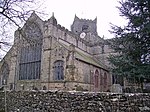St Peter's Church, Field Broughton
Church of England church buildings in CumbriaDiocese of CarlisleEngvarB from September 2013Gothic Revival architecture in CumbriaGothic Revival church buildings in England ... and 2 more
Grade II* listed churches in CumbriaPaley, Austin and Paley buildings

St Peter's Church is in the village of Field Broughton, Cumbria, England. It is an active Anglican parish church in the deanery of Windermere, the archdeaconry of Westmorland and Furness, and the diocese of Carlisle. Its benefice is united with those of St Mary, Allithwiate, St Mary and St Michael, Cartmel, St John the Baptist, Flookburgh, St Paul, Grange-over-Sands, Grange Fell Church, Grange-Over-Sands, and St Paul, Lindale, to form the benefice of Cartmel Peninsula. The church is recorded in the National Heritage List for England as a designated Grade II* listed building.
Excerpt from the Wikipedia article St Peter's Church, Field Broughton (License: CC BY-SA 3.0, Authors, Images).St Peter's Church, Field Broughton
Pease Close Lane,
Geographical coordinates (GPS) Address Nearby Places Show on map
Geographical coordinates (GPS)
| Latitude | Longitude |
|---|---|
| N 54.228 ° | E -2.9419 ° |
Address
Pease Close Lane
LA11 6HY , Staveley-in-Cartmel
England, United Kingdom
Open on Google Maps








